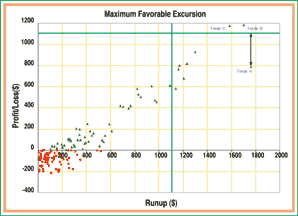MONEY MANAGEMENT
Maximum Excursion -- With A Twist
Setting Stops And Taking Profits With Maximum Excursion
by Sergei Dobrovolsky
This simple new variation on John Sweeney's maximum excursion method should help you determine how well your system takes profits and cuts losses.
Let your profits run, but don't get too greedy. Cut your losses short, but give your trade some space to develop. While discretionary traders by necessity find an intuitive balance between these ideas (or quit trading), system developers have the luxury of being able to backtest their strategies. This technique, a variation on John Sweeney's maximum excursion method, will help you determine how well your system takes profits and cuts losses.
The maximum favorable excursion (MFE) and maximum adverse excursion (MAE) methods were developed by John Sweeney in several articles published in Technical Analysis of STOCKS & COMMODITIES. They are based on plotting a scatterplot diagram showing each trade's final profit or loss versus its maximum runup (for MFE) or drawdown (for MAE). Runup and drawdown are defined as maximum unrealized profit and loss during each trade.

FIGURE 1: MAXIMUM FAVORABLE EXCURSION (MFE). By adjusting profit-taking cutoff levels, you can end up with a system that results in better profitability.
...Continued in the August 2002 issue of Technical Analysis of STOCKS
& COMMODITIES
Excerpted from an article originally published in the August 2002 issue of Technical Analysis of STOCKS & COMMODITIES magazine. All rights reserved. © Copyright 2002, Technical Analysis, Inc.